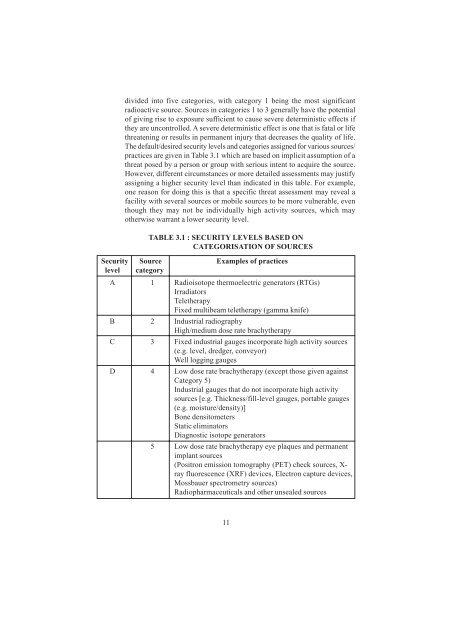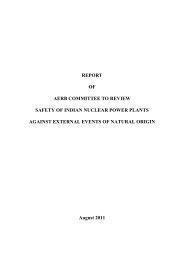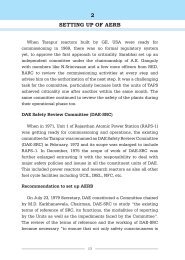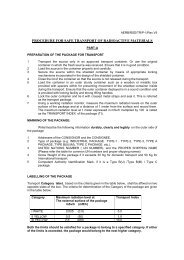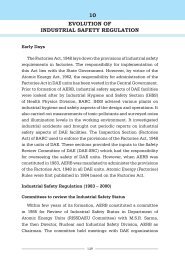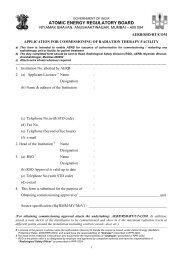Security of Radioactive Sources in Radiation Facilities
Security of Radioactive Sources in Radiation Facilities
Security of Radioactive Sources in Radiation Facilities
You also want an ePaper? Increase the reach of your titles
YUMPU automatically turns print PDFs into web optimized ePapers that Google loves.
divided <strong>in</strong>to five categories, with category 1 be<strong>in</strong>g the most significant<br />
radioactive source. <strong>Sources</strong> <strong>in</strong> categories 1 to 3 generally have the potential<br />
<strong>of</strong> giv<strong>in</strong>g rise to exposure sufficient to cause severe determ<strong>in</strong>istic effects if<br />
they are uncontrolled. A severe determ<strong>in</strong>istic effect is one that is fatal or life<br />
threaten<strong>in</strong>g or results <strong>in</strong> permanent <strong>in</strong>jury that decreases the quality <strong>of</strong> life.<br />
The default/desired security levels and categories assigned for various sources/<br />
practices are given <strong>in</strong> Table 3.1 which are based on implicit assumption <strong>of</strong> a<br />
threat posed by a person or group with serious <strong>in</strong>tent to acquire the source.<br />
However, different circumstances or more detailed assessments may justify<br />
assign<strong>in</strong>g a higher security level than <strong>in</strong>dicated <strong>in</strong> this table. For example,<br />
one reason for do<strong>in</strong>g this is that a specific threat assessment may reveal a<br />
facility with several sources or mobile sources to be more vulnerable, even<br />
though they may not be <strong>in</strong>dividually high activity sources, which may<br />
otherwise warrant a lower security level.<br />
TABLE 3.1 : SECURITY LEVELS BASED ON<br />
CATEGORISATION OF SOURCES<br />
<strong>Security</strong> Source Examples <strong>of</strong> practices<br />
level category<br />
A 1 Radioisotope thermoelectric generators (RTGs)<br />
Irradiators<br />
Teletherapy<br />
Fixed multibeam teletherapy (gamma knife)<br />
B 2 Industrial radiography<br />
High/medium dose rate brachytherapy<br />
C 3 Fixed <strong>in</strong>dustrial gauges <strong>in</strong>corporate high activity sources<br />
(e.g. level, dredger, conveyor)<br />
Well logg<strong>in</strong>g gauges<br />
D 4 Low dose rate brachytherapy (except those given aga<strong>in</strong>st<br />
Category 5)<br />
Industrial gauges that do not <strong>in</strong>corporate high activity<br />
sources [e.g. Thickness/fill-level gauges, portable gauges<br />
(e.g. moisture/density)]<br />
Bone densitometers<br />
Static elim<strong>in</strong>ators<br />
Diagnostic isotope generators<br />
5 Low dose rate brachytherapy eye plaques and permanent<br />
implant sources<br />
(Positron emission tomography (PET) check sources, X-<br />
ray fluorescence (XRF) devices, Electron capture devices,<br />
Mossbauer spectrometry sources)<br />
Radiopharmaceuticals and other unsealed sources<br />
11


